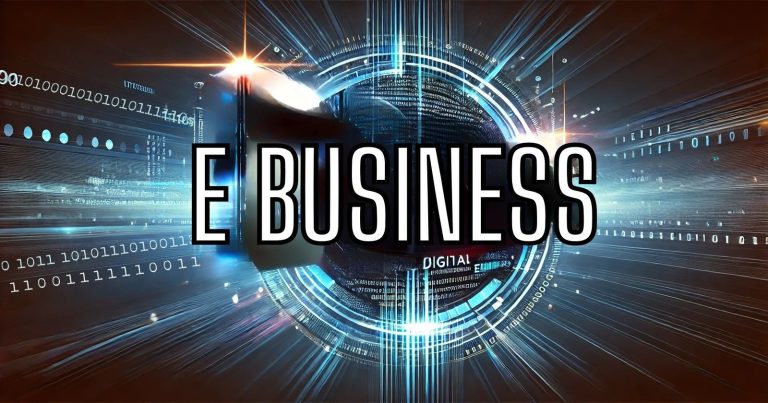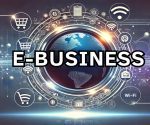E business has revolutionized the global economy and has enabled businesses to be conducted online, thereby reaching customers all over the world. Like any innovation, it has its own disadvantages as well. Disadvantages of e business may impact companies and customers both. It impacts the level of trust, efficiency, and profitability. Hence, to compete in this highly competitive marketplace, businesses have to weigh all these challenges.
What is E-Business?
E-business is the practice of doing business over the Internet. It ranges from purchasing and selling products to service provision, supply chain management, and directly interacting with customers. It extends beyond the horizon of e-commerce in that it encompasses activities like customer relationship management, digital marketing, and enterprise resource planning.
Definition and Scope of E-Business
E-business uses a digital version of the traditional business. Some of the tools that help streamline operations and increase customer engagement include websites, mobile apps, and social media. Although it offers convenience and global reach, some of the limitations of e business such as technology dependency and competition must be addressed for sustained growth.
Examples of E-Business Activities
E-business activities range from various industries:
- Online retail: Amazon offers products to customers in every corner of the globe.
- Digital marketing: Facebook and Google allow business people to market directly to their target markets.
- Cloud services: Dropbox and Microsoft 365 make it easy to share files and collaborate with others.
- Streaming platforms: Netflix offers subscription-based entertainment around the globe.
Features of E-Business
The features of e-business allow companies to serve customers effectively and adapt to changing market trends. These special characteristics make it a foundation of modern commerce.
- Accessibility: E-business allows customers to shop or access services at any time and from anywhere. It does away with geographical constraints, and businesses can reach international markets without much hassle. This is particularly useful for e-retail and digital services.
- Automation: Automation is key to e-business because it frees up the administration processes in inventory tracking, order fulfillment, and customer issues. It reduces the intervention that occurs with human beings, minimizes mistakes or wrong procedures, and accelerates operations. Businesses save time and resources and therefore concentrate on innovation and customer satisfaction.
- Cost-Effectiveness: E-business saves a firm the costs of running a brick and mortar; no rents, utilities, and on-ground staff. It allows them to then sell their wares at near-competitive prices yet pass savings onto the consumer. The cost-benefit also presents a convenient way by which start-ups can enter a competitive market.
E-business integrates several functions like sales, marketing, logistics, and finance into one system. It thus streamlines operations easier tracking and monitoring data for consistent patterns across platforms. Real-time analytics improve the decisions as well.
E-Business vs Traditional Business
E-business and traditional business differ at a very basic level; the difference in nature significantly changes how both deal with the approach with the customer as well as manage their internal functions. These differences can help business concerns while determining an appropriate operating model for business needs. The difference between e business and traditional business are:-
- Location: Traditional businesses are location-specific and have physical setups. The systems are geographical area-specific. E-businesses solely exist in cyberspace, whereby a company can reach out to clients elsewhere in the globe.
- Customer Contact: Direct contact through personal meetings exists in traditional business. This tends to establish trust and relationships. In e-business, the only form of contact is digital, at times seeming to lack intimacy.
- Cost: Traditional businesses incur higher overheads of running, such as rent, utilities, and ground staff. E-business incurs fewer overheads, thereby providing an e-business firm with the extra flexibility of deploying more funds for marketing and innovation.
- Multiplication Rate: E-business multiplies faster than traditional business because digital platforms enable it to multiply more easily.
- Customer Preferences: The e-business attracts the more technologically informed, whereas the traditional business appeals to customers who prefer first-hand experience.
- Payment Methods: E-business makes use of digital payment systems like credit cards and e-wallets, while cash is the preferred mode of payment in traditional businesses.
| Aspect | Traditional Business | E-Business |
| Location | Location-specific with physical setups. | Operates in cyberspace; not tied to a physical location. |
| Customer Contact | Direct contact through personal meetings, fostering trust and relationships. | Contact is digital, which may lack intimacy. |
| Cost | Higher overhead costs (e.g., rent, utilities, staff). | Lower overhead costs, enabling more funds for marketing and innovation. |
| Multiplication Rate | Expands relatively slowly due to physical constraints. | Expands rapidly due to digital platform scalability. |
| Customer Preferences | Appeals to customers preferring first-hand experience. | Attracts technologically informed customers. |
| Payment Methods | Cash is the primary mode of payment. | Digital payment systems like credit cards and e-wallets are used. |
Disadvantages of e business
E business has changed the character of the operations and the interaction between companies and their customers. Still, there are disadvantages of e business and some inbuilt limitations that create quite a big problem. The impacts that these disadvantages will have on both businesses and customers determine the degree of their satisfaction and overall trust. The firm has to fight through such challenges if they will survive.
Security Risks
Probably the most significant disadvantage of e-business is security risk. Cyber attacks, data theft, and hacking attempts expose information, including client data and monetary transactions. Online websites are a target for criminals to exploit weak points, making it a great cause for concern for customers and businesses alike.
- Impact on Customers: Customers are hesitant to give their personal and financial details online as they fear misuse of that information. For instance, if an e-store is a victim of a data breach, then the customers would lose confidence and never again conduct any transaction in the future.
- Impact on Businesses: Companies incur reputational loss and financial losses when they do not secure their systems. Companies need to ensure that they implement effective cybersecurity measures to avoid such instances.
Example: An online shopping website was hacked; this would lead to loss of credit card information of the customer, which in turn would be a loss of customer confidence and lawsuits.
No Personal Contact
No personal contact exists in an e-business. This limitation creates a problem in making the parties develop trust between themselves, and it reflects a gap in customer satisfaction.
- Customer Challenges: Customers love to see, touch, or try the products before purchasing, particularly clothes or electronic appliances. The denial of such experience by online shopping may cause dissatisfaction.
- Business’s Problem: A firm cannot develop such a close bond with the customer, which eventually impacts loyalty and retention for the long haul.
Example: A customer will order clothes through an online portal, but ends up getting either the wrong size or color from what was ordered, disappointing the customer further and leading to returns.
Leverage with Technology
E-business is a business dependent on internet connection and technological setup. If technical problems like a server stop or a website crashes, work comes to an immediate standstill, and some monetary loss is incurred.
- Problems during Peak Period: Peak periods include visits due to slower sales periods. It makes websites crash.
- Effects on Small-Scale Businesses: Small business ventures cannot afford better technology; thus, the disturbances are likely to occur more.
Example: A festive sale on an e-commerce platform crashing can lead to lost revenue, frustrated customers, and a tarnished reputation.
Logistical Challenges
Logistics for global deliveries pose complexities that traditional businesses may not face. Delays, high shipping costs, and damaged goods all negatively impact customer satisfaction.
- Customer Expectations: The customer will demand faster and more efficient delivery. If there is any form of failure, trust will be eroded.
- Business Operations: Return rates and unsuccessful deliveries are increasing the rate as they require highly sophisticated tracking systems
Example: A product will not have been packed properly so it reaches the customer in a damaged form; at that time, the customer loses confidence in the quality of e-business standards.
High Competition
The entry barrier reduces in e-business and, accordingly, the market is full of high competition. Also, more business establishments happen on the internet, and gaining mileage or enlisting customers turns tough.
- Effects on Small Scale Businesses: Tough competition against the likes of Amazon and eBay by SMEs
- Need for constant innovation: It means that constant adaptation is necessary and this process becomes resource-intensive too.
Example: An online small-sized retailer would find it hard to compete with large-sized online platforms, especially when those sites offer discounts and faster deliveries.
Limited Product Scope
Some products, for example, perishable items, are not possible for e-business due to problems related to logistics and quality.
- Customer Barriers: A customer will not like ordering fresh fruits or vegetables through online shopping as the chances of them getting spoiled are very high.
- Business Barriers: Specialized packaging and storage for quality at the time of delivery add to the cost.
Example: Fresh seafood delivery across regions is difficult as it requires temperature-controlled storage and timely delivery.
Digital Divide
The limited reach of e-businesses is because not all customers are equipped with the means of a reliable internet connection or other digital devices.
- Impact on Customers: Customers, who do not have an internet facility, can not access any e-business website and hence cannot be included.
- Impact on Business: Companies target other markets simply because the requisite kind of infrastructural facility is available elsewhere.
Illustration: As internet is so weak in most rural areas. Customers are always finding it impossible to place a telephone order for an online store or even communicate with an online vendor.
Return and Refund Complexities
Handling returns and refunds is a major limitation of e-business. While in traditional businesses, customers return products in the store, in e-business, there is a need for extra logistics.
- Problems for Businesses: Repeated returns add to the operational cost, while the risk of fraud increases with false claims.
- Customer Experience: Complex return procedures annoy customers and create negative feedback.
For example, an online fashion store: has high returns because ‘not the right size’ with a high cost for the online fashion retailer and is logistically challenging.
Disadvantages of E Business FAQs
What are the biggest drawbacks of e-business?
The biggest drawbacks include security risks, less personal interaction, and dependence on technology and logistics.
What is the difference between e business and traditional business?
E-business functions online; there is a global reach, whereas traditional businesses rely on physical stores and local interactions.
What are the limitations of e business?
The disadvantages are: high competition, limited product suitability, the digital divide, and complexities in returns and refunds.
What is the impact of security risks on e business?
Cyberattacks and data breaches damage the company’s reputation and loss of customer trust thus causing financial damage.
Why is e business a disadvantage in the respect of personal contact?
Customers become alienated, or unsure, about products due to which customers become dissatisfied and possibly become disloyal.


